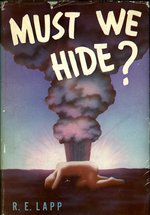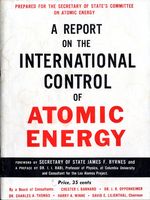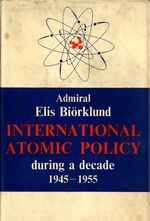Edward Teller, a prominent member of the Manhattan Project, had been working on calculations for a more powerful bomb since his time in Los Alamos. According to his theoretical work, a two-stage bomb in which a fission reaction compressed material to create a secondary fusion reaction would be several hundred times more powerful than a conventional atomic weapon like Little Boy. He envisioned a bomb that used tritium gas, also known as hydrogen-3, to create the fusion reaction. In honor of that gas, he called this new weapon the hydrogen bomb.
Following a great deal of discussion among America's political elite - including the USAEC, the Senate and House Joint Committee on Atomic Energy, and the President himself - it was decided that a hydrogen bomb program should begin in earnest.1 There was much resistance to such a weapon but the Soviet threat was a persuasive one. In 1952 the first hydrogen bomb was exploded in the Ivy Mike test on the Eniwetok Atoll. The bomb proved to be nearly 1000 times more powerful than the weapon detonated at Hiroshima.
The nuclear era was progressing in other arenas as well, and the year 1954 saw the creation of one of the most important pieces of atomic legislation in American history. "The Atomic Energy Act of 1954," an amended version of the 1946 act, was designed to facilitate the communication of atomic technical information.2 The bill encouraged the development of a civilian atomic industry by allowing nuclear-related patents, granted private companies access to certain technical data, and allowed limited sharing of atomic information with foreign nations. The law was a direct result of President Eisenhower's "Atoms for Peace" initiative which aided foreign nations in studying peaceful uses for atomic energy.
Despite any surface efforts to create an international climate of open discussion, the Cold War was in full bloom: the Iron Curtain had descended over Eastern Europe, violence had erupted in Asia, and a secret war was raging between clandestine Soviet and American agencies. Ultimately, the level of mistrust between the U.S. and Russia lead to the creation of war plans like Operation Trojan, which dictated the virtual annihilation of large and mid-sized population and industry centers in Soviet-controlled Europe through an aggressive program of nuclear strikes. Hostilities, both violent and political, would continue until the fall of the Soviet Union in 1991.
Notes
- 0553. U.S. Congress Joint Committee on Atomic Energy. The Hydrogen Bomb and International Control: Technical and Background Information. Washington, D.C.: USGPO, July 1950. UF767 .U48. Return to text ↑
- 0523. Losee, Madeleine W. Legislative History of the Atomic Energy Act of 1954 (public Law 703, 83rd Congress). Washington, D.C.: USAEC, 1955. KF2138.A313 A15. Return to text ↑




